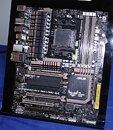Wednesday, January 9th 2013

ASUS Unveils World's First PCI-Express 3.0 Motherboard for AMD Processors
ASUS did the unthinkable yet simple, by innovating the first AMD platform motherboard that features PCI-Express 3.0 x16 slots, the Sabertooth 990FX/GEN3.0 R2.0. Long naming aside, the board provides you a couple of gen 3.0 slots by using PLX-made 48-lane PCI-Express Gen 3.0 bridge chip.
While the board features four PCI-Express x16 slots, only two similarly-colored slots can be used at a time, of which two are PCI-Express 2.0 x16, wired to the 990FX northbridge, and two slots being x16/NC or x8/x8-capable, being wired to a PLX 48-lane PCI-Express Gen 3.0 switch, which in turn takes two PCI-Express 2.0 x16 links from the northbridge.Apart from this unique feature the socket AM3+ Sabertooth 990FX/GEN3.0 R2.0 features AMD SB950 southbridge, eight SATA 6 Gb/s ports, two eSATA 6 Gb/s, 8-channel HD audio, six USB 3.0 ports, and a zesty ASUS-exclusive feature-set. The new board could be released to the market very soon.
While the board features four PCI-Express x16 slots, only two similarly-colored slots can be used at a time, of which two are PCI-Express 2.0 x16, wired to the 990FX northbridge, and two slots being x16/NC or x8/x8-capable, being wired to a PLX 48-lane PCI-Express Gen 3.0 switch, which in turn takes two PCI-Express 2.0 x16 links from the northbridge.Apart from this unique feature the socket AM3+ Sabertooth 990FX/GEN3.0 R2.0 features AMD SB950 southbridge, eight SATA 6 Gb/s ports, two eSATA 6 Gb/s, 8-channel HD audio, six USB 3.0 ports, and a zesty ASUS-exclusive feature-set. The new board could be released to the market very soon.

43 Comments on ASUS Unveils World's First PCI-Express 3.0 Motherboard for AMD Processors
Sandy Bridge, Ivy Bridge = 1 x PCI-E 2.0 x16 lane to a 48-lane PCI-E 2.0/3.0 switch.
There is a reason why Ivy Bridge is only 200 MB/s faster than 990FX with a 680 GTX in bandwidth.
The IC on the motherboard is PCI-E 3.0 but Ivy Bridge is indeed PCI-E 2.0 connected to PCI-E 3.0. How you can tell actual native PCI-E 3.0 from fake PCI-E 3.0, PLX Switches.
BTW, it's not just the switches, SLI support in BIOS also plays a role in PCIe 3.0 support. Boards without SLI, all support PCIe 3.0; P67, H67, Z68, Z75, H77, Z77 all inclusive.
If there are no PCIe switches between the CPU and the card, the card will run at it's maximum speed, in that case GEN3.
I think you're referring to the fact that SLI NEEDS switches on 1155 to operate (it requires x8 traffic, for both GEN2 and GEN3), otherwise you'd be stuck with a fixed configuration 8x8 board. The switches are there to redirect the traffic to the first card in case the clockgen in the PCH doesn't detect a card in the second slot.
It's like when adding IVB support to BIOS, something weird happened.
I almost want to say that AMD allows PCIe 3.0 for VGA on PCIe 2.0 bus, regardless of bridges or what have you. If it's just encoding or whatever, I don't know. X79 is why I want to say that..you get PCIe 3.0 with AMD on any X79, NVidia on X79..not so much.
Don't forget x16/x4 boards, too.(support Crossfire, but not SLi, no bridges)
Not MSi products, but as you know, I've used very few MSi boards. ;)
Thanks very much for the input though, when it comes to MSi, of course your word is king. ;)
None of you OEMs really agree as to what's what, so I can only hold you to MSi products.
That's why I said, Intel is leading in this. Follow Intel's guidelines and you're good, skimp on them and you're bad. I just wish there was a mandatory certification for GEN3 :(
RE: The X79 part, It has everything to do with time spent validating and certificating, but after a while it was fixed: www.techpowerup.com/168027/NVIDIA-Releases-PCI-Express-Gen-3.0-Enabling-Patch-for-Sandy-Bridge-E-HEDT-Platform.html
And yes, a real standard would be great. :p